Happy 20th, Rise of the Triad!
I moved from Pennsylvania to Texas in December of 1992. I took a job with 3D Realms (then just called Apogee Software). I left a company of 70,000 to come work for a videogame company in Garland of around 20 or so (most of that was order takers at the time). I stayed there from Dec 1992 to May of 2009 when a bunch of us were notably laid off during the development of Duke Nukem Forever. During all that time I either participated in or was witness to the development of a boatload of games. But in all that time I was a true developer in just one of them. That was Rise of the Triad.

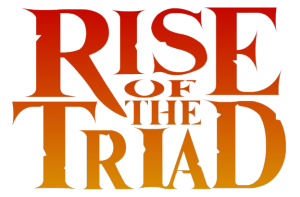 Rise of the Triad turns 20 years old today (Dec 21st, 2014). It was 20 years ago today that v1.0 of the shareware episode was uploaded to the world (by me) to the Software Creations BBS, and from what we used to use as our FTP archive back in the day (wustl.edu). This was put out in the era of Doom, and while ROTT, like any game had its issues, it was by far my favorite game of any I ever worked on in any capacity during my time at Apogee/3DR.
Rise of the Triad turns 20 years old today (Dec 21st, 2014). It was 20 years ago today that v1.0 of the shareware episode was uploaded to the world (by me) to the Software Creations BBS, and from what we used to use as our FTP archive back in the day (wustl.edu). This was put out in the era of Doom, and while ROTT, like any game had its issues, it was by far my favorite game of any I ever worked on in any capacity during my time at Apogee/3DR.
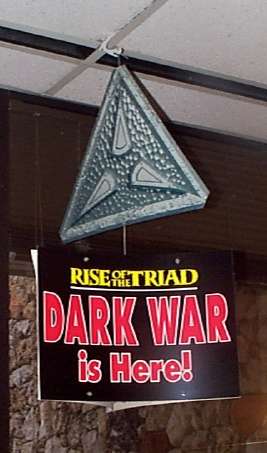
ROTT was first internally developed game by Apogee (3DR hadn’t yet come into existence as a brand name at this point). At the time, much was made of wanting to develop “true” in house games (vs the “out of studio” type games we had done to that point), and Rise of the Triad was going to be the first. In fact, I remember going out to dinner to meet with the first developer hired, the late great William Scarboro. Scott, George, and myself took William out to dinner, and William and I struck up a friendship that would remain going forward, even past his death (more on that later). One thing that I had forgotten about which I was reminded of during my research for this article is one of the more notable firsts. Rise of the Triad was the first 3D action game to have the ability to play as women or as people of color.
We brought in other developers to work on Rise of the Triad, including Nolan Martin, Mark Dochtermann, and Jim Dosé. Jim had submitted a platformer game to Apogee called “Megaloman” that was never released (no, I’ll never stop referencing that Jim), but ROTT ended up using Jim’s sound code. Jim became the sound code guy for a while there, as his code was used in multiple games of this era (Boppin’, Hocus Pocus, Realms of Chaos, etc). But of course, our project lead was none other than Tom Hall, fresh over to Apogee from his time at id Software. Tom came off Doom due to creative differences, and we were more than happy to have him. I knew Tom both as a fan of his work (I had bought Commander Keen back in the day, as well as Wolfenstein 3D) as well as a professional colleague, as I would go over to id and do things like shoot pool with Romero & Tom. So to be working with Tom was a bit of a dream come true. Most of what made Rise of the Triad what it is, is down to Tom. There’s just so much in there to talk about, I’d be writing until the 21st anniversary to cover it all.
That wasn’t all of the team. There’s plenty others who worked on ROTT as well. Lee Jackson did the bulk of the music on the game, with an assist from Apogee/id legend Bobby Prince. Susan Singer, Chuck Jones, Stephen Hornback, James Storey, & Tim Neveu also rounded out the dev team. There were also several of us who did maps. Myself, Mark’s later wife Marianna, & Joe Selinske (along with Tom) were the main map team. Rob Atkins did the really slick looking game manual as well.
I look back on all of this with fond memories. We were the “Developers of Incredible Power”. Some of this group formed the original Prey development team, but that is a different anniversary article. Haha. I get the feeling I’m forgetting someone from the team, but I hope not. If I did, it’s a mea culpa for sure. Granted, it was 20 years ago, and I’ll be 50 next year, so some of the memories start to fade, but there’s some great stories.
Team ROTT Photos
My Stories
Speaking of stories, I originally intended this piece to be a “history of ROTT”. I started writing in that direction, but decided against it, as it wasn’t feeling right. I wanted to write to my strength, which was stories about what happened – because I’d be writing from my point of view, not speaking for others so to speak. So, without trying to tell a story with the stories, here are several random bits I recall from my time on Rise of the Triad. Some I’ve told before over the years, some I haven’t, but all are from my own head. :)
Power Outage on evening of release
The night of the 1.0 release of Rise of the Triad Shareware, we had a total power failure in the neighborhood. The whole team was there, and this was 1994, so even if we had any UPS devices, it wouldn’t have been enough to do development on, we had to basically stop and do nothing for awhile. While we were down, we basically did random things like play board games, walk around the building, take naps, blame id Software for the power loss (haha), and some of us (Mark Dochtermann) decided to launch water rockets in the lobby of the office. There’s a pic on the ROTT CD in the extras directory of this. We called the rocket “The Avenger” for some reason that escapes me now. It failed miserably, went up about a foot or so, and Mark got soaked. Was a great stress reliever, though. I wish we had gotten a pic of Mark getting soaked, but we were all laughing too hard, and didn’t. This is the only known picture of Mark with “The Avenger”.
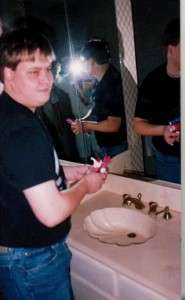
Krist’s “Bleh”
My character in ROTT was such that you didn’t hear a lot of what he said. Due to the way the game handled sound, and the fact that you really couldn’t get terribly close to my character without taking damage, you generally didn’t hang around Krist enough to hear what he said. Most of what was said was relevant, but a few were rogue weird noises. Other than the aforementioned “relevant” bits (“Hey, Come Back here”, “you’re dead” – that kind of stuff), we didn’t have a huge script. In fact, the voice recording was pretty primitive compared to these days. It was done at the computer in Tom Hall’s office, and we had a single, simple microphone and we did a few takes. I don’t recall listening to the takes afterwards and redoing them, but that had to have happened. After I recorded the “relevant” bits, Tom had us adlib a few lines. One of the things I said was “Bleh”. This wasn’t just stupid speak, it was a reference to a game I played a lot at this time. It was one of Tom’s old Apple IIgs games called “The Legend of the Star Axe”. I had a IIgs on my desk at Apogee at the time, and used to play this at work. One of the characters in that game said “Bleh”, so this was me honoring that game. Tom said at the time, I had the highest known score in that game.
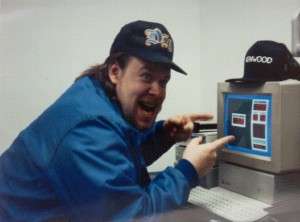
Coffee Cup Multiplayer
At the time ROTT came out, the world was on fire with Doom deathmatch. For good reason, it was all kinds of awesome – we played a lot of it at the Apogee offices. So when you were putting out a game AFTER that, where do you go? Well, we had a buttload of different styles of gameplay. Not just straight up “Deathmatch”, we had a ton of others ways to play. We also wanted to go past the generally accepted (in 1994) number of players, which was four. We wanted to go all the way to 11. I can’t recall if picking 11 players was a reference to the movie “This is Spinal Tap” or not, but there you go. So the problem with testing 11 player deathmatch is that you didn’t always have 11 players to play at the same time. What do you do when you need that many players to play at once and don’t have them? You break out the coffee cups! What we would do generally is not have true deathmatch sessions with 11, it was mostly done to test the networking code. We just needed to see if all 11 players stayed in sync over the numerous connection methods (anyone remember parallel port connections?) Anyway, we would go to some of the computers and just stick a coffee cup on the fire button so there would be active constant input from all 11 players, even if they weren’t really “playing” as such. The funny thing is that on a couple of occasions the coffee cups would actually beat live human players. That was sad. And funny at the same time.

“God Mode”
I’d been asked a few times over the years why we used the phrase “Woundless with Weapons” instead of the more commonly used “God Mode”. This had to do with the fact that Doom popularized that phrase, and given Doom was itself just a year old at this point, we didn’t want to use that phrase. It kind of “belonged” to Doom. That is not the case now, but in 1994, that was the way it was perceived. I know it was felt internally that we shouldn’t directly copy things that were “Doom things”. To that, “God Mode” was changed to “Woundless with Weapons”. That wasn’t the only thing. We didn’t want to call multiplayer “Deathmatch” – again a “Doom thing”. We called it “Comm-Bat”. We did end up using “God Mode” in the game as a mode, where you walked around as a giant hand that threw “Godballs”. The rather boomingly loud sound in ROTT for “God Mode” was Tom Hall imitating something John Romero did during Doom development. John would turn on God Mode in doom and clip through the walls as “God” making that exact sound. So in the end, we did use something from Doom, I guess.
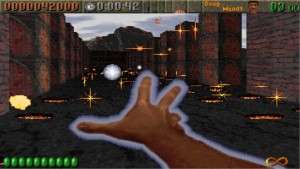
The Gad Sheet
ROTT was my first and only professional game as a developer, and it was working with a guy who was one of my heroes before I got into the industry – that was way cool. It was fun coming up with things and tech in the game, and one of the things that was an on the fly thing that I recall were “gads” (Gravitational Anomaly Discs). They’re the little silver discs which could be suspended in air. Anyway, Rise of the Triad was done with the same editor that Wolfenstein 3D & Commander Keen (and a host of others like Bio Menace) were done with. Its name was “Ted”.
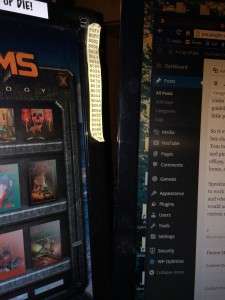
With gads, however, you had to figure out the proper hex values for each gad so if you wanted to make a stairwell of gads, you had to place them at the right spot. Each Gad item placement had to have it’s height set via secondary (or tertiary, I don’t recall right now) values. If you put them too close it looked really stupid, and if you placed them too far apart, your character would get stuck on them. Tom Hall eventually figured out a sequence of hex codes that would make a proper stairwell of Gads in ROTT. He printed it out on a piece of paper, and stuck it to his monitor (as he did the bulk of the ROTT levels and needed this info a lot). This was the general guideline for gad stairs in ROTT. It was tweaked sometimes, if you wanted a different visual look to your stairwell for some aesthetic reason, but this little piece of paper of Tom’s was the defacto guideline for ROTT stair/gad building.
So it was a surprise to me that when Tom left Apogee to go do Ion Storm in August of 1996, on his last day, he handed me the little Gad paper with his hex chart. I don’t remember exactly what he said, but it was something along the lines of “You’re now the official keeper of the GAD chart”. I even asked Tom today if he remembered what he said, and he doesn’t, but did recall the exchange. (We’re fairly sure it wasn’t something involving a scroll, robes, and pinpricks of blood, however.) So from that day on until right now, I’ve had that piece of paper on my monitor. This included the changes in 3DR offices, as well as my departure from 3DR in May of 2009. As I write this text on Dec 19, 2014, that small piece of paper is STILL on my monitor at home, and has been on every monitor I’ve ever had since 1996. It is looking a bit worse for the wear over time, but I still have it!
Speaking of Ted, there was a weird story about it I always got a kick out of. Given it was an older tool from the Commander Keen days (this was all pure DOS development), it required a really freaky mouse driver to work right. What you had to do was have a batch file which unloaded your regular mouse driver, load the custom Ted mouse driver, run the editor, and when you quit, unload Ted’s driver, and reload your regular one. With a batch file, it wasn’t a big deal, but if you forgot to run the batch file, Ted would act really strange. On the final day of development of Rise of the Triad, Mark Dochtermann fixed the mouse bug so you didn’t need to load the custom mouse driver anymore. Good that was fixed in a timely fashion. :)
One last thing about the GAD sheet. When I was working on this article, I showed Tom the picture here and said “Look at what is still with us in 2014”. Tom’s response.. “eGADs”. :)
Shareware Credit Scrolls
There were several point releases of the shareware version. We had 1.0, 1.1, 1.2, & 1.3 (as well as a 1.2a, but that was an “oops” release). ROTT had lots of things, but one thing it had in spades was a sense of humour. That was largely down to Tom and his personality. I feel the game was richer because of that. The registered version had some epic end credits too, but lost in the overall story are the differences and the silliness in the shareware credits. When you finished the shareware game, you got a few bits of “legitimate” credits, and then the goofiness starts. After “The End”, someone (probably Tom) thought it would be funny to put silly text in there. I’ve embedded a Youtube video below showing you this. But the reason I wanted to write about it is that the fun part was the brainstorms for these. I use plural, because the 1.0, 1.1, & 1.2 versions all had different end credit scrolls. We didn’t do it for 1.3, as we had gotten bored with the idea by then. But the first one and the second one I recall several of us sitting around Mark Dochtermann’s desk and brainstorming goofy crap to put in the end credit text scrolls. The final one in 1.2 I think was Mark, myself, and maybe one or two others, I think most had checked out by then, and when it came time for the final update, nobody wanted to do it anymore. But I loved the communal brainstorm it took to create these goofy credit texts. That is why I bothered to write about this. The “Oooh, I got a good idea” type feeling when the whole team was sitting around was a cool feeling. It’s not something you can really do with a team that is spread out over the world.
Given I’ve been called a “data crazed fanatic completist”, here’s the list of credit scrolls for the various shareware versions, as well as a video from v1.2
Version 1.0:
1) You’ve won the battle, Cassatt. But when the Oscuridos return, will you be ready as they wage their Dark War?
2) Armed with only a pistol and 30 bucks, you must stop the minions of El Oscuro before they kill millions of innocent people.
3) Take a vacation. You’ve earned it. Maybe on San Nicolas Island…
4) Thanks for playing. If you liked “The HUNT Begins”, check ordering info for information about continuing your adventure.
5)
6)
7)
8) Look, this is pointless. You are done. Push off.
9)
10) Wow, you must like this fine background screen.
11)
12)
13) Sigh.
14) All right, um . . . you found the secret message! Congratulations!
15) Didn’t work, huh? Okay, how about this . . .
16) THE END
17) Dang. Thought I had you there.
18) Stop watching. Pretty please?
19) With sugar on top?
20) Wait . . . I could just go to the demo loop! See ya.
After #20, one of the patrol robots comes on the right side of the screen and the text “Am I late?” appears over his head.
Version 1.1:
#1-#12 Same as Version 1.0
13) Fnord.
#14-#18 Same as Version 1.0
19) Bet you were expecting some new messages in Version 1.1.
20) Well, too bad. This is the only one.
21) OK, I lied. There are 2 different messages. So sue me.
22) Actually three is a nice number. That’s it. Hope you enjoyed it. P.S. did you find the new cheat codes?
After #22, the patrol robot comes out.
Version 1.2:
#1-#12 Same as Version 1.1
13) “Bob”
#14-#18 Same as Version 1.1
19) You know that if you registered, there would be a lot more cool stuff happening right now.
20) Episode IV : A New Hope
21) Just think of all the new secret messages you could find hidden in the registered version!
22) Someone right now is probably enjoying the really exciting ending of the registered version.
23) ROTT was filmed before a live audience.
24) No animals were harmed during the creation of this video game, although one dog did get its butt spanked when it peed on the carpet.
After #24, the patrol robot comes out.
NOTE: The dog mentioned above was Loki, referred to in the manual as “Loki, the carpet wetting maestro”. Loki was also the model for the snout in dog mode.
William Scarboro
I was friends with pretty much everyone at Apogee during the making of this game, but one guy I hooked up with a lot was William Scarboro. William had a lot to do with ROTT. He was a guy who was fun to be around, and he and I had eventually evolved our relationship to the point where we didn’t have to say anything at all. We’d just see each other and start laughing. Both of us tended to be the kind of person who would laugh at the same thing over and over, so our repeated jokes to each other became nonexistent, we would just laugh when we’d see each other. So much to talk about with William, for this story, I’ll talk about some of the fun stuff. In the office, one of our favorite things we’d say to each other was “Uhh…. 27”. This was a reference to Beavis & Butthead when they tried to sneak into an “R” rated movie and the teller asked them how old they were. Butthead’s response was “Uhh…. 27”. So that became our catchphrase. We’d go to concerts together from time to time (I remember a show in Dallas when we saw Motley Crue with Type O Negative), and just generally had a laugh when the other was around. We enjoyed the same things, so it made it easy to like William. He was also really focused when he was working. His brain would reject things that weren’t part of his process. We even once put a turtle next to him to break that thought process, and it took quite a while for his brain to register that the turtle was even there! William spent most of his time coding the game, but he did dabble a little in level design. One of the levels he did was called “The Sanctum of Rocking”, whose title fit his personality really well. So I miss my friend. I really loved that Interceptor dedicated the 2013 Rise of the Triad remake to the memory of William. I also like that the picture they used of him in the dedication was one I took way back when. William was responsible for a lot of the really cool stuff in there. Worked on actor code, weapon code, but the one thing he is probably most known for was the /EKG cheat code. ROTT had a very high level of violence and gibs in it, and given the constraints of DOS back in the day, everything was bound by memory limits. This extended to the violence. It was limited so that when you played the game, it wouldn’t drag down by having so many body parts and blood splatter all over the place. However, William so loved that kind of stuff, he was responsible for the EKG (Engine Killing Gibs) cheat code which removed that restriction, and really let the stuff fly. It could if there were enough enemies around really cause slowdowns, which we didn’t want during normal gameplay. But that one was all William. He did a lot of the weapon code in the game, the drunk missile was William’s creation.
William Scarboro RIP
Which brings us to the flip side of William, his death on August 9, 2002. William left 3D Realms a little after Tom Hall left to go do the Ion Storm thing with Romero. Of the ROTT team, I’m pretty sure William was first in, last out. I was at Apogee/3DR for almost 17 years, and saw a LOT of people come and go. William’s departure bugged me more than most, because he was that kind of “see them and laugh for no reason” kind of friend. There wasn’t this thing called social media then, so you had to make an effort to keep in touch with people then. We drifted apart a bit, and eventually lost touch, which I regret now, I could have made a better effort to keep in touch with William post 3DR. I wasn’t even sure where he had worked, I knew it had something to do with programming, but after he left 3D Realms, he never worked in videogames again. It was on August 19th I was contacted by a fellow who was working with William who wanted to inform us as his “original” employer that William had died. It was quite the shock, and even knowing what I found out later from his mother, it still was a really sad thing. William died of an asthma attack at age 31. William was super healthy, he always ate the right way, worked out, and died at age 31 anyway. THAT SUCKED.
I would have gone to his funeral had I known, and that’s also part of my regret in losing touch with an old friend. I could have had I made the effort, and I didn’t, so I lost out on that. When the ROTT team moved on to Prey before that original incarnation fell apart, William was the original engine guy and our lead programmer (as Mark Dochtermann had gone). William spent a lot of time in the earliest days of Prey, and it is for that reason, and for my old friend that some years later after Prey game out in 2006 that I had a thought. I wanted to meet William’s mother. I lucked out and wrote back the guy who emailed me four years previous, and he was still there. He arranged a meeting with William’s mother, Pearle. What I wanted to do was present her with two gifts. One was a photo album I threw together of pictures of her son from his time at our company. The other was a copy of Prey. Now I know William’s work didn’t survive into the final version of the game, but the legacy of the product has his name on it, and Prey was dedicated to his memory, much in the same way that Interceptor did with ROTT in 2013. Anyway, because of all that, I wanted her to have a copy of the game that her son worked on in a big way in its formulative days. Told her that I know she wouldn’t ever play it, but that wasn’t the point. It was a powerful meeting, she told me stories about William I had never heard before, and I found out a few things that made his death a bit sadder in some ways. Given the deeply personal nature of that meeting, I won’t spill the beans on everything, but a few of the things his mother told me were:
- The asthma problem that took his life was something he’d been dealing with since he was a kid, and they knew from a VERY early age he likely wasn’t going to live much past age 30. Turned out that was the case sadly, but William KNEW that as a kid. That had to be one hell of a thing to live with. Don’t know if I could have pulled that off.
- William was her only child, and her only family left in the world. When William died, she was alone with no family. That really stabbed me in the heart.
- One cool thing she told me is that after William died, she got his car, and was still driving it – in fact she drove it to the meeting we had.
That meeting with her was both super sad, and super joyful at the same time. I felt COMPELLED to contact his mother and give her these things, show her that we hadn’t forgotten his son, that someone still cared. Writing this part of the article brought up a lot of memories for me, and I don’t think I ever really put out there how I felt about William, or as we called him “Da Hur” (inside joke). I miss my friend. Miss ya William.


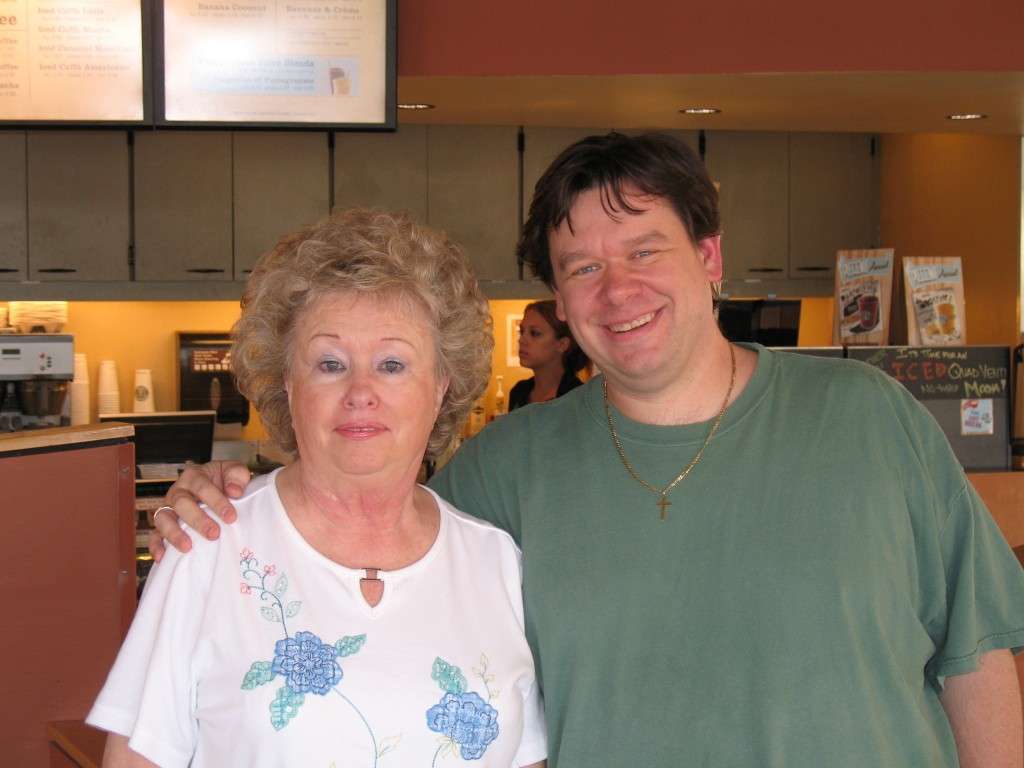
Extreme Rise of the Triad
As I said earlier, ROTT was the only game I was a formal developer on during all my time at Apogee/3DR. I did something (sometimes small) for every game, yes – but as a “formal game dev”, ROTT was on my one shot. Which is why I liked EROTT so much. EROTT was as Tom has said elsewhere a fun couple of month project. But for me personally, I got more out of it than Tom did. The reason for that is that he and I were the ONLY developers on it. Since it used ZERO new game coding, nobody else was needed. This was just a level pack really, although the (not very strong) marketing at the time pushed it as a lot more. What made this work I think was the fact that Tom and I figured out all kinds of tricks with the engines that we didn’t realize we could do in the original game. Because of this, some of the levels tended to have freakier design and layouts than the original game did.
Tom came up with the idea of having Ballistikrafts standing on top of each other, and made them go pretty high – and a new name was born – Ballistitowers. I expanded on my sound zone tricks from the original Vomitorium, and would have giant empty rooms, until you flipped a switch, and suddenly 50 guards would appear out of thin air. Then I started doing jerk things like having four fireballs pointing immediately at the initial spawn spot in the level, so if you didn’t move instantly, you were dead. Or invisible elasto modes where you would fall off the level if you hit it too fast.
However, one of my favorite EROTT levels was “A Boulder Vision”. It occurred to me that the game didn’t feature the boulders a lot. They were in there, but none of the mappers really did a lot with them. So I decided to make a level around the boulders. I figured out all kinds of tricks with them. The game engine knew about left, right, forwards, and backwards for boulders, but it had no concept of “up and down”. So what I found is that if you could get a boulder to another level besides the floor, it would do its thing there. That’s how I had flying boulders. You just started the boulder rolling somewhere where the player wasn’t, make a stairwell of gads, send the boulder that way, and it would go up the stairs. Thing is, it didn’t know how to get back down, and once a boulder was up in the air, it was stuck there, you couldn’t go down, as “reverse gad stairs” didn’t work – the boulder would just get stuck. I know, I tried. So it was these kind of weird engine tricks and design that made EROTT more fun for me than the original. Plus as I said earlier up, I was a fan of Tom Hall’s work from the pre-ROTT days, so the fact that I got to work one on one on a project with him was awesome to me personally. EROTT was never actually pushed that hard, and that annoyed me a bit. It was in retail on store shelves, and that was cool. But there was no real “push” to sell the game, and it disappeared pretty quickly. Which impacted my royalty checks for that a lot. Haha. But all good. EROTT is a great memory for me both personally and professionally. I wish it sold more, and got more attention than it did, but I can’t complain too hard due to the Tom connection the project made for me.
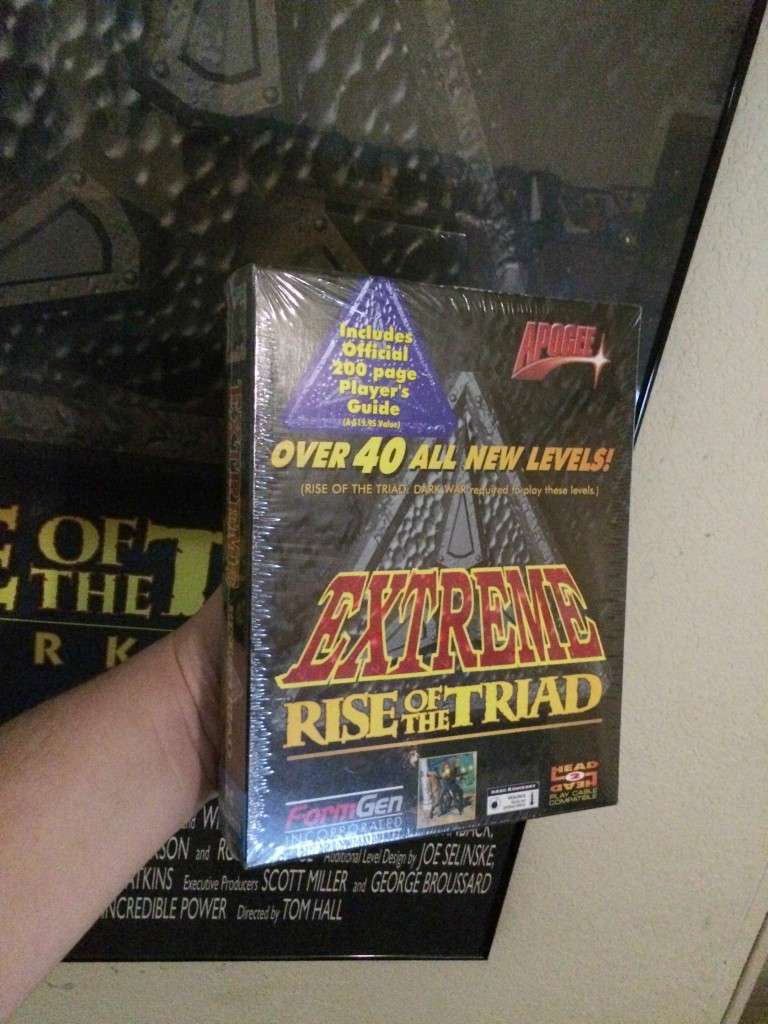
Dopefish Lives
It is well known that I’m one of the folks who drove the concept of cameos by Dopefish in games. It started here at Apogee, and then when people would leave and go elsewhere, it kind of branched off from there, and became a self perpetuating thing after awhile. But of course, being a dev on this game, I had to work one in. It wasn’t the FIRST Dopefish reference – I think Wacky Wheels might have been that. But Tom was keen on certain development rules – his “design tips” document was a set of rules that he laid out for the internal development team. At the time, it was intended to be the base from which all internal games were guided by their design, so things didn’t get (relatively) too out of control. One of those rules was that Tom didn’t want you drawing messages in the walls for the player to see through the natural progression of the game. If you did it where it could only be seen by using cheat codes, that was OK, but he didn’t want us leaving messages in the walls. So I’m working on my Eight Ways to Hell level, which was an enormous level. To that, I was having difficulty at one point coming up with a pattern for the walls in one room. I was thinking about a Dopefish cameo around this time, and while I knew Dopefish was in there as a command line parameter, I wanted something else. Given Tom’s design document restriction on that, I tried to come up with a way to still leave a message, but honor Tom’s request. Thought of one. I asked Tom if I could use the “Standard Galactic Alphabet”, which was the alphabet Tom created for the Commander Keen games. My thinking was that most people wouldn’t recognize that in the map unless they were told about it, and if they DID recognize it, it would be a cool easter egg. Tom approved that idea, and so my usage of “DOPEFISH LIVES!” in my Eight Ways level went out. Later on, Tom allowed me to totally blow out the rule by actually spelling out (in English) “Cheat Now” in my “Grand Vomitorium” level for EROTT. Telling the user to “Cheat Now” was kind of a silly joke, because the only way you’d ever actually SEE that level anyway was to cheat.

The Build Engine
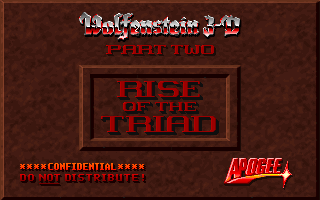
There’s other things that I sort of remember, but did not have a ton to do with directly. Like the decision to stay with the Wolfenstein 3D engine. As I’m sure most know by now, ROTT started life as “Wolfenstein 3D Part II: Rise of the Triad”. This was Tom Hall’s “bridge” project to bring him to Apogee from his days at id Software. Later on, id rescinded the rights to use the Wolfenstein name. When they did that, we were at a crossroad. Ken Silverman was working on his Build engine then, which at the time was being used for early development of Duke Nukem 3D, and other games like Blood and whatnot. There was a choice for the ROTT team to move to that, and it was decided at the time that we would stay with the Wolfenstein3D engine. Nobody wanted to throw out all the work we had done to that point. Moving to the Build Engine would have meant completely starting over from scratch, and I don’t think anyone wanted to go back to square one. On top of that, the Build engine wasn’t 100% rock solid yet, and I think the team wanted to go with a more known quantity (at least I think that was the case, I wasn’t a programmer). ROTT could have been the first Build game. Had we made that decision, it probably would have meant that ROTT was remembered a bit more fondly, as most agree the 90 degree angled walls (which were a tech limitation of the base Wolfenstein 3D code) probably hurt the game’s perception in people’s eyes. I still thought it was hella fun, and to this day I enjoy the ol’ girl. But it might have done better with the Build engine insofar as user reception goes.
The FlameWall
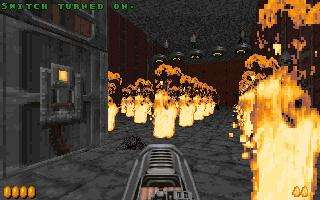 Going back to William Scarboro for a bit. One of the things he did more than any other thing was weapon code. At least that was my perception. The drunk missiles were his conception, and while he didn’t originate the flamewall, a lot of what made it what it was was down to him. There’s a funny flamewall story that I wanted to relay. At one point, William broke the flamewall, and it would set EVERYTHING on fire, and it would stay that way. It wasn’t what you knew, basically everything it touched caught on fire and stayed that way. Another flamewall problem was when the flamewall ran into a stairwell of gads, the flame would try and climb the stairs. That never made it out to public, but I can remember the visual, it was quite hilarious, because it was so gloriously broken and awful looking as an effect goes. :) William would usually call one of us over, going “Look at this shit!”. It was decided not to leave that in, because it didn’t look good, but we all had a laugh.
Going back to William Scarboro for a bit. One of the things he did more than any other thing was weapon code. At least that was my perception. The drunk missiles were his conception, and while he didn’t originate the flamewall, a lot of what made it what it was was down to him. There’s a funny flamewall story that I wanted to relay. At one point, William broke the flamewall, and it would set EVERYTHING on fire, and it would stay that way. It wasn’t what you knew, basically everything it touched caught on fire and stayed that way. Another flamewall problem was when the flamewall ran into a stairwell of gads, the flame would try and climb the stairs. That never made it out to public, but I can remember the visual, it was quite hilarious, because it was so gloriously broken and awful looking as an effect goes. :) William would usually call one of us over, going “Look at this shit!”. It was decided not to leave that in, because it didn’t look good, but we all had a laugh.
One last flamewall story I wish we had a picture or video of.. This was after Rise of the Triad, when Prey had started development. William took the concept of the flamewall into the original incarnation of Prey. While I don’t believe this proto weapon ever had a formal name, I referred to it as the FlameSphere. If you remember what the Flamewall did, it was basically flame on a single plane. Given the multi dimension and total bizarreness that Prey was (especially in its early versions), you can imagine this. The FlameSphere’s basic idea was to have a moving wall of flame that burnt everything in its path (like the Flamewall), except in EVERY DIRECTION SIMULTEANOUSLY. That was all kinds of awesome to see. There were of course logistical and mapping problems with a weapon like that, but it was really cool to see. I wonder if the code for that exists anywhere anymore, be awesome to see that again.
The NME / “Spray”

The NME is one of the harder bosses in Rise of the Triad. If you’ve ever played the game, you know what I mean. NME stood for “Nasty Metallic Enforcer”. Even in testing, we had issues beating him easily. I think in some ways he was harder than the final boss (El Oscuro), but Oscuro was more interesting. Anyway, the internal nickname we developed for NME was “Spray”. The reason for this was William Scarboro referenced the buttload of missiles that the NME fires at you as a “Spray” of missiles, and the name stuck. We even put a Texas license plate on the back of the NME that said “Spray”. In the normal course of the game, this was brutally hard to see, as it was nearly impossible to get behind the NME – he would always turn around to face you, and if you were near him, you were dead. But it wasn’t just “Spray”, it had that “William attitude”. Like it was said “Spraaaaay”. That we put a license plate on the robot was always comical to me.
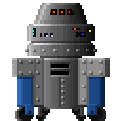
Another story about the NME was that after the game was released, we were getting reports that the NME was crashing the game in his own level. This shouldn’t be possible, as his room was pretty coded to be solid. Turns out people were luring the NME out of his room (which isn’t easy), and trying to kill him by getting him down to the spinblades that were in another part of the level. In earlier versions of the game, the NME would hit the blades and the game would crash. This was due to the fact that the bosses in ROTT had very specific programming, and if you did things with them that we didn’t program for, the game would crash. It never occurred to us that people would lure the NME out of the room into spinblades elsewhere in the level, so there was no coding for that. It was fixed in a patch, though. This is why in EROTT the bosses are the same, and in the same exact level “slots” as they were in the original. It is why the game crashes in my Vomitorium level when you kill the NME, as he was not ever intended to appear in that level slot.
The models for the various robots were done by Gregor Punchantz, the same chap who did the models for Doom. I remember at the time thinking that was so cool, having the “Doom guy” do our models. For a time, they were in my offices at Apogee, and later moved to the trophy cases in the 3D Realms lobby in Garland. After the fall of my version of 3D Realms, the “new” 3D Realms offices were in space in the Triptych offices in the Gearbox building. The ROTT models were there for awhile until Interceptor bought 3D Realms. I was under the impression that they had the ROTT Models, but they told me they don’t. Need to track down what happened to them.
The Vomitorium
I couldn’t not say a few words about my Vomitorium levels. When I was doing Rise of the Triad levels back in 1994/95, my levels tended to skew harder than most of the other mappers. As such, most of my stuff tended to be pushed to later in the game, as most games have a ramping up of difficulty as you progress. Heck, in Extreme Rise of the Triad, the bulk of mine were in “Episode 4”, and that game was considered bastard hard right from the start. Or they were Warp Only levels. Such is the case with a level I’m probably most known for – The Vomitorium (and its sequel, “The Grand Vomitorium”.
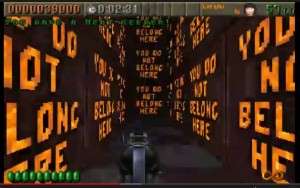 These levels were created to exploit engine oddities, and was basically me running amok in the editor. The editor that was used by the artists for the Wolf3D engine art had some issues if you got to the end of the string of tiles. If you tried to go past it, it would crash or some such shit. So Steve Hornback put the “You Do Not Belong Here” tile in there (it’s on both ends of the string of tiles, technically in there twice), and the thinking was that if you saw it, you were supposed to stop scrolling, avoiding a possible crash. Memory was very precious back in those days, so loading up all those graphics in the DOS graphics editor was an issue.
These levels were created to exploit engine oddities, and was basically me running amok in the editor. The editor that was used by the artists for the Wolf3D engine art had some issues if you got to the end of the string of tiles. If you tried to go past it, it would crash or some such shit. So Steve Hornback put the “You Do Not Belong Here” tile in there (it’s on both ends of the string of tiles, technically in there twice), and the thinking was that if you saw it, you were supposed to stop scrolling, avoiding a possible crash. Memory was very precious back in those days, so loading up all those graphics in the DOS graphics editor was an issue.
I asked the programmers once if there was a technical reason why I couldn’t use that tile. Anyway, the programmers said no (as it was a limitation of the graphics editor, not the game), so I used it. I knew it wasn’t a viable tile for a standard level, but for one of my strange “Warp only levels”, sure – I could see that. I never intended entire rooms to be filled with that tile either, but when I discovered it looked REALLY weird combined with shrooms mode, the Vomitorium concept was born. The gags on the Vomitorium level were there because of weird engine things in the old Wolf code. Sometimes I exploited the engine’s sound zones for effect as opposed to just visual placing of objects. That is how I hid the NME in the final room of the first Vomitorium. He was there, but in a different “sound zone”, so invisible until you broke the plane of his “square”.
Anyway, the original level started as a gag on the “You Do Not Belong Here” tile, and once I realized how sick it made some of the people at Apogee to look at it combined with shrooms mode, I expanded on it, and just ran with it, making it more dickish. The level also crashed when you killed Spray. That usually goes against all known game developer logic, but it was allowed because of two reasons. First, we already crashed the game intentionally with the “This Causes an Error” level, and second, Tom Hall reasoned that since you had to cheat to get to the level in the first place, all bets were off. In addition to it being that difficult, I also made it super hard to complete the level. First off, the main room was as high as you could make a level, and EVERY wall tile was “You Do Not Belong Here”. The true path out of the level (without cheating) involved a SINGLE gad way up high in the level that you had to ride all around the room until you got over all the stuff that would kill you. It was hard even SEEING this one tile, so even knowing that was the path forward was not obvious. Then once you figured it out, just getting ON the tile was super hard as there was one jump pad to get on it, and it’s not easy to find it. Frequently you’d would have to wait for the gad to do a full cycle before you can get on it. Then even when you got on it, you could easily fall off into a side area where I left you no way out – except a rocket that you could use to kill yourself. Then of course the only way to survive the NME at the end was to cheat, as there’s no way to kill him legitimately.
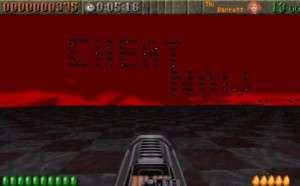 The Grand Vomitorium basically started off as a 100% duplicate of the original, except there was no ceiling to the level – just for a different visual. Some of the tricks later on in the level were made better because there was no ceiling – like the elevator that seemingly left you in the middle of the sky. Oh, and walls coming in out of the sky, too. I was really trying to be a jerk with my level design in this one, since it was a warp only level in an addon pack which was already generally harder than the original. Probably why Tom allowed me to totally violate design custom by drawing the words “Cheat Now” in the level. As one video called me out on Youtube for, this was probably the height of my “dickish level design”. I adored that actually. That video I’m speaking of (link below) by Psychadelic Eyeball is one of the funnier things I’ve seen about my own work. Level designers for the most part don’t get direct feedback on their levels. They’re just kind of put out there, and that’s it, but I cannot tell you how many times I’ve watched that one – “That’s really not kind, Mr. Siegler”…. hahaha. I had a lot fun with engine exploits and hiding things which would make the player want to swear at me. :)
The Grand Vomitorium basically started off as a 100% duplicate of the original, except there was no ceiling to the level – just for a different visual. Some of the tricks later on in the level were made better because there was no ceiling – like the elevator that seemingly left you in the middle of the sky. Oh, and walls coming in out of the sky, too. I was really trying to be a jerk with my level design in this one, since it was a warp only level in an addon pack which was already generally harder than the original. Probably why Tom allowed me to totally violate design custom by drawing the words “Cheat Now” in the level. As one video called me out on Youtube for, this was probably the height of my “dickish level design”. I adored that actually. That video I’m speaking of (link below) by Psychadelic Eyeball is one of the funnier things I’ve seen about my own work. Level designers for the most part don’t get direct feedback on their levels. They’re just kind of put out there, and that’s it, but I cannot tell you how many times I’ve watched that one – “That’s really not kind, Mr. Siegler”…. hahaha. I had a lot fun with engine exploits and hiding things which would make the player want to swear at me. :)
To finalize the Vomitorium story, there was a new level in the 2013 remake of Rise of the Triad. That level was called “Escape from the Vomitorium”. What I thought was really cool about that was the fact that they took my initial room from the first two Vomitorium levels and made it a 100% copy before going through the first door and off into the all new stuff. I loved that homage to my old work, and I was especially touched when I contacted Simon Rance (the 2013 Vomitorium mapper). Told him I loved it, and that I was touched by the honor that he took my design and used it completely in the new map. If there ever is another ROTT, and a Vomitorium IV, I think I’ll push to have that first room in the fourth one. Seems like a tradition now.
To bounce back to the OG Vomitorium – the intended path of the level is to end in a crash as you kill the NME when you cheat. However, in the new 2023 version, that doesn’t happen anymore. You see, the reason the game crashed is that in the OG ROTT, there was special programming in the specific levels that the four bosses appeared in to deal with their deaths, and show a cinematic for that. When you used a boss outside of their original level number, there was no special programming, and the game crashed (hello Vomitorium). Well, in the Ludicrous Edition, the folks over at Nightdive put in new coding which stops that. So the Vomitorium level in this version shows the “NME has died” cinematic, then goes back to the menu.
There’s a couple of videos about my Vomitorium Levels:
The first one is Psychadelic Eyeball’s excellent commentary on BOTH my Vomitorium levels. The second is Civvie11’s great EROTT video, which isn’t just about the Vomitorium, but it’s touched on. Also.. “EAT EAT EAT EAT LEAD!”. The final video is someone else playing through the 2013 version in “Escape From the Vomitorium”, which ends in you being eaten by the Dopefish. I wish I would have thought of that in 1994.
One final factoid on the Vomitorium level. The level was named after an old Saturday Night Live sketch called “Roman Vomitorium”. That particular episode was hosted by Burt Reynolds and aired on 12 Apr 1980. According to Civvie, Extreme Rise of the Triad is a ball-breaking platformer. I was glad to contribute to that. :)
NOTE: I re-wrote parts of this section on 6 Jul 2023 for the upcoming re-release of ROTT ’95 in the “Ludicrous Edition”.
Level Names
Several of my levels were named after things that meant something to me. In fact, three of the levels I did were named after a few ex girlfriends of mine. The majority of the levels tended to be named by the person who created them, but that wasn’t always the case. I know Tom had some better suggestions for some of my original level name choices. I also wanted to include a list of some (not all, there’s too bloody many) Rise of the Triad levels and why they’re called that. This is not intended to be an exhaustive list, it’s just ones that I know for sure (since I did them), or am 100% positive about the story. Plus not EVERY level was funny in its name choice.
- Pykus Peak, A Mode I Rode, The Hoppe Hop – All mine, all from EROTT, and all named after ex girlfriends. Ended up marrying the one the first one was named after.
- Ride ‘em Cowboy – Mine. Called that because it was the first level you had to ride gads to progress (it was level 6 in Shareware). During dev, I actually would make Cowboy sounds doing testing – it was quite sad.
- Rise and Tide – Tom Hall. This was something a game magazine called ROTT during a pre-release preview. That they botched the name like that was too good not to use somewhere. Got a level named after it.
- Clear and Present Dangers – Tom Hall. The movie “Clear and Present Danger” was out in 1994. You figure that one out.
- Eight Ways to Hell – Mine. This was a level that I created where the intent was to have every conceivable way the game engine could kill you in the same level all at once. I can’t remember the connection to “Eight Ways”, as there were a lot more than eight ways to kill you in the game, but that was why the level was so massive.
- Dead in Two Seconds – Tom Hall. Aptly named, as if you didn’t move, you honestly were killed in two seconds.
- The Vomitorium – Mine. I really messed with perception in this, the idea was to make you sick playing the game with shrooms mode times about 5,000. The level itself however, was named after an old Saturday Night Live sketch from 1980 with Burt Reynolds also called “The Vomitorium”.
- This Causes an Error – Tom I think – I’ll cover that later in the “I’m Free” section.
- The Corpseyard – William Scarboro. This was aptly named, as it was envisioned as one of those short tiny levels where you’d kill someone, and you could run back and kill him from your spawn spot in virtually no time. The idea was that you could kill so many people, there’d be huge piles of corpses lying around. Of course the game couldn’t visually support that, but that was the reason for the name. Was also the first listed level in the shareware’s Comm-Bat mode, so it was probably played the most.
- One Stop Gun Shop – Tom Hall. Originally not intended for release, was a test level with every weapon and every object in it at the same time when you needed to test something new in the game code. Was modified for public release somewhat.
- Cross Purposes – Mine. Was named after the then new Black Sabbath album of the same name. Level was shaped like a giant cross.
- Technical Ecstasy – Mine. Was named after an older Black Sabbath album from 1976. The idea was that this level was mostly all robot enemies, and that album cover had two robots on the front.
- Yellow Brick Road – Tom Hall. Wizard of Oz reference.
- Triadagio – Mine. Was a reference to Lee Jackson’s song in the same level “Adagio”. Noticed the first two letters of that were the last two of Triad, so a name was born. Actually, the full name of the song was “Adagio for Strings and Organ in G minor”, but that’s too long for a level title.
- Krist Cross – Mine. Was named (indirectly) after the truly horrid kid band at the time of the same name. Was also the level Sebastian Krist was in, so that’s where the original idea for “Krist” in the name came from. Speaking of Krist, my character’s name is a Red Dwarf reference. Sebastian Krist is named after “Col Sebastian Doyle” from the episode “Back to Reality” from S5 of that show.
- 95 Windows – Mine. Named after the then new “Windows 95” OS. Also, if you look in the map editor, there were exactly 95 windows in the map grid. I counted them.
- Gods of Annihilation – Mine. This was a joke level. It was the shortest level in the game, you literally started one square away from the exit, and there was one low guard to shoot. Given it was SO short, the idea in giving it such an epic sounding name was itself a joke.
- Stupid Dog Tricks – Tom. A reference to the old David Letterman bit of the same name.
- Use the Fish – Joe Selinske. This is a reference to then id Software Jay Wilbur. When we legally asked id for permission to use Dopefish as a cameo character in the game, Jay’s legal response to us via fax was very short, saying basically “Go ahead and use the fish”. A level name was born.
- Wan Fife – Joe Selinske. This was one of the more interesting attempts at level design in ROTT. As stated earlier, we played a lot of Doom in the offices. So did anyone at that time. One of the levels that got played more than any other was Romero’s famous 1-5 level. Get it? 1-5, Wan Fife? This level attempted to recreate the level geography from that Doom level in ROTT. It didn’t work of course due to engine limitations (and was relegated to the reject pack), but some of the basics could be recognized if you knew Doom 1-5 really well.
- Spears of Density – Joe Selinske. This was named after a customer of ours who couldn’t get the name of the Wolfenstein sequel, “Spear of Destiny” right.
- But This Goes to 11 – Tom Hall. This was a reference to the movie “This is Spinal Tap”.
- Dwayne Goes 48 – Mine. One of the more popular attempts back in that day to corral game play into a central online area where people could go was the service Dwango. I loved one of their maps, specifically Dwango Pack 4, Level 8. Hence the name of this level – “Dwayne Goes 48”. It attempted to recreate that level geography as well. A bit better than Wan Fife. Haha
- The X Factor – Mine. This was named after the then new Iron Maiden album.
- Hey! More Barrels – Tom Hall & Selinske – This was a common phrase heard around the office during development.
- Urge to Kill – Jim Dose. Was named after a Simpsons Halloween episode where Homer Simpson would say “Urge to Kill – Rising”, which itself was modeled after the movie “The Shining”.
- They Say HOO-Man-Ay – Mine. Named after the sound that monks made, as this level used a ton of them.
- You & Spray – Mine. This was the final level released by Apogee/3DR for Rise of the Triad. It was a personal exercise, because when I did it, I hadn’t messed with the editor in ages, and I did this one level to see if I still remembered how to do it. It was basically 100% of the map grid in the game in one gigantic room. You on one side, and the NME on the other side. He fired rockets instantly, but given how gigantic the room was, it took like two minutes for them to get to you. When they finally did, it was an epic shitload of rockets.
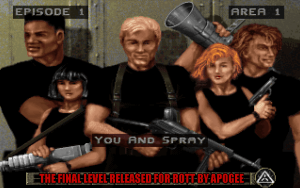
I’m Free!
The last story is one called “I’m Free”. This is a reference to a map error in Rise of the Triad. Things that moved around the map were essentially stupid. You defined them as moving, and they’d take off and move. And would continue to move until they hit a map marker to tell them to change direction. So basically it was up to the mapper to come up with a proper working maze of arrows in the editor for all the moving walls to follow. If you didn’t, and made a mistake, the moving wall (or whatever) would just keep going until it got off the side of the map grid. That was bad, because anything that attempted to exist outside of the map grid would crash the game. (Think dividing by zero kind of issue). During map design, we would frequently make mistakes, and send pushwalls off the side of the map grid. It was annoying, because you then had to go back into Ted and follow your own path. I know I had one map path that was really weird as I had about a dozen walls all moving around 2-3 paths in a room, and it was hard to follow my own work at times. The pushwall error happened enough that one time Joe Selinske had experienced it, and just shouted “I’m Free!”. Tom being Tom drew the now famous “I’m Free” image which is a representation of the pushwall having escaped off the side of the map grid. We thought it was hilarious, I scanned in his drawing, and a trap was put in for the crash that would be generated by this error, and displayed the image. It of course was the intended behavior for two warp only levels, the aptly named “This Causes An Error!” and “This Causes an Error Too!”. The image made us laugh so hard, we created dummy levels just to show it! Haha.
This is what Joe Selinske had to say about “I’m Free”.. “I do get deep satisfaction and a lot of laughs thinking back to when that whole “I’m Free” gag was running around Apogee. I am the bastard who started it, Tom [Hall] drew it, Joe [Siegler] scanned it in and Mark [Dochtermann] put it in the game. There were so many things going on during ROTT development that it scares me to think about them. Wow, that was some fun. But way too many inside jokes if you ask me. ;)”
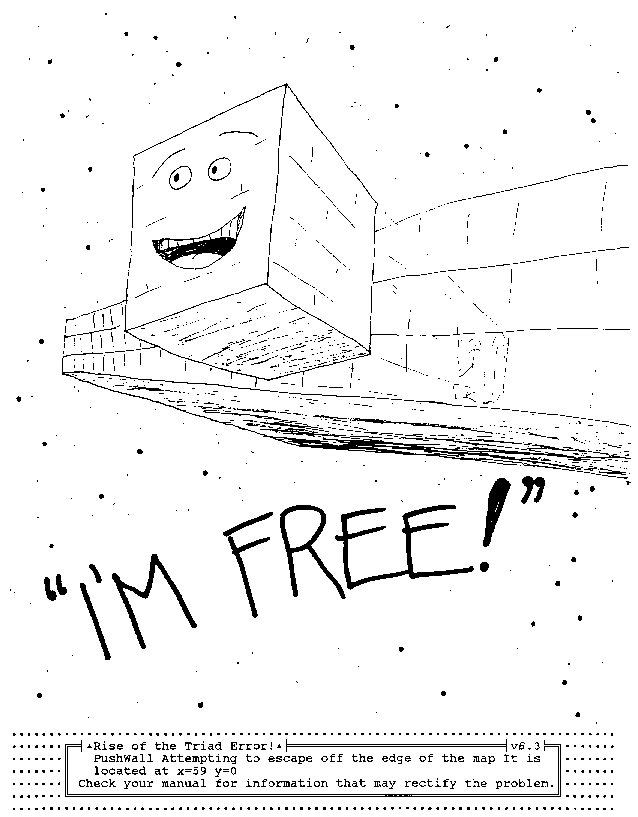
Those are all my stories for this article. There are many more stories to tell, and this is also just MY article. All the others on this team could tell their own stories, and write their own perceptions, but over the years it seems like I’m the one who has taken on the mantle of company archivist, and the one who tends to write about these historical bits. Still, this is what I thought of in the 4-5 days before the 20th when I spent thinking about the game.
Rise of the Triad 2013
That’s not where this story ends, though. When I lost my gig at 3D Realms in 2009, I figured that was the end of all of that. I wrote elsewhere on my blog about the end of my career, and it was a rather cathartic thing to write, because I well and truly felt that the 16.5 years I spent at Apogee/3DR, and the one as a contract worker at Gearbox were the end of my time in the videogame industry. All during my time at 3DR, I would constantly tell people that of all the games I ever worked on in my time there, the ONE I wanted to see revived for a new game was Rise of the Triad. ROTT was by far and away my favorite game we ever did. For any number of reasons (I was developer, just darned fun, etc) I wanted that one to be have a sequel, or be remade. So in 2012 it was to my great pleasure to find out Interceptor was doing a Rise of the Triad game. It was a surprise for me, and I honestly loved it. There were so many things in the old ROTT game that were there because of technical limitations of the time. Like the gads. 2013 game tech doesn’t need a crutch like that, but the Interceptor guys kept all the weapons, and all the stuff like gads in the game – even though they didn’t have to. They also kept one of the more important, but not very well talked about things from the original. The lightning fast method of gameplay. That was something I really liked. They kept the spirit of the original, while updating the tech, which was – let’s face it horribly out of date. The original game was fun, and is still enjoyable, but the tech is very old at this point. So as one of the original developers, I enjoyed watching it redone and brought up to a modern audience. I felt they respected the original, while doing something new and modern with the tech. They didn’t try to “reinvent” it, basically. Which is a mistake a lot of retro games make, IMO.
I was asked to participate, and I did in a few ways. We had a few consulting sessions over Skype. One I remember in particular was quite bizarre. We had a discussion over the proper behavior of the Dopefish. I actually found myself saying “I don’t think the Dopefish would actually do that”. After the phone call was over, it was quite a weird feeling consulting on Dopefish behavior in 2012. Haha. I also was Sebastian Krist again. The guys from Denmark had me send some new digital scans of myself over via Dropbox, and they put my head on the new Krist model. That was especially bizarre seeing myself in the game again like that. One of the most surreal things was attending Quakecon 2012 where ROTT and the Apogee logo was reintroduced to the world, and people could play it on the show floor. The entire time I was there, I was thinking “I can’t believe I’m seeing this”, so for the Interceptor crew, yeah – thanks guys. I really loved that my favorite project was brought back into the light. Sequel someday? Maybe? :D
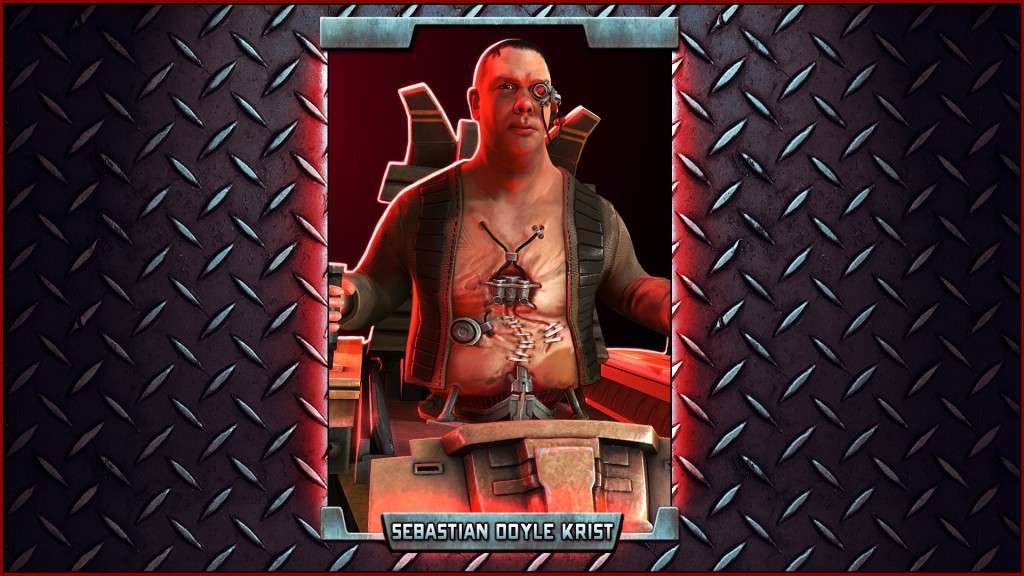
Pyschadelic Eyeball
I wanted to give a shout out to a fellow on Youtube who goes by the name of “Psychadelic Eyeball”. This dude did a series of videos in the middle of 2010 where he basically played through all of ROTT, and recorded his commentary on what he was doing. I ATE THESE VIDEOS UP. Obviously, I was more into hearing what he said about my levels, but I watched all of them. As a level designer, you generally tend to design in a void. Oh sure, you get team feedback from what you’re doing – but every single level designer on every game has those “bits” that they put in their work, that they do for themselves. You always wonder if people will notice things like this. This guy picked up on several such things that I did (like the invisible Elasto mode in the Grand Vomitorium). It was FREAKIN GOLD to hear this kind of feedback on your work, even if it was about 15 years after the fact. I don’t know what your real name is dude, but I LOVED LOVED LOVED your videos, thanks for doing them. Also, while getting ready to write this monster of an article, I rewatched the ones on my levels to try and put my own head in the right place to recall tidbits about the game. I mean, it WAS 20 years ago. I enjoyed these videos as much now as I did before. I’m going to include my favorite – the one where he talks about my two Vomitorium levels, but I strongly urge you to check out his entire series, it’s very much worth your time if you were a fan of the original Rise of the Triad.
Where Are They Now?
It has been 20 years since Rise of the Triad came out, and when doing these kinds of articles, it seems natural to wonder where the team is these days. I’ve decided to do a rundown of the team, and what’s happened to them since ROTT graced our computer screens.
- Tom Hall – Tom was the initial producer for Prey. When he left to form Ion Storm, he did the criminally underrated Anachronox. After Ion Storm, was at a few different companies over the years, releasing another underrated title, “Hyperspace Delivery Boy”. These days, he’s at Playfirst Mobile games, and is the lead creative director of their product line. For ROTT, Tom did most of the level design (over 30 levels) and overall design and production. He played the role of El Oscuro and did the voices for the Monks, and “God Mode”.
- William Scarboro – I wrote about William above, but I’d be remiss by not including him here. As has already been detailed, William died in 2002. After he left 3D Realms, he never worked in videogames again, and remained a programmer of business and financial software up until his death. I believe William is the only person from ROTT’s original team that is no longer with us. For ROTT, William did most of the actor coding. He also was the voice of the Lightning Guard and was the Alternate Lightning Guard character (which didn’t make it into the actual game).
- Mark Dochtermann – Mark left 3D Realms with several others to form Hipnotic Software (later more well known as Ritual Entertainment). After working at Ritual for awhile, Mark worked at Electronic Arts for awhile, before ending up at Google, where he remains to this day as an engineering manager on Niantic Labs. He also made the game Ingress. For ROTT, Mark wrote the engine and communications \ networking code (among other things). He also did the voices for General Darian and played the role of the Alternate DeathFire Monk, which didn’t make it into the game.
- Jim Dose – Jim left 3D Realms with several other folks to form Hipnotic Software (later more well known as Ritual Entertainment). He stayed there for awhile, and also worked at both id Software (on Doom 3), as well as Valve Software. These days, Jim works at Occulus VR along with John Carmack (ex of id Software). For ROTT, Jim wrote the sound engine and RANDROTT (as well as other general programming things). He also was the voice of Ian Paul Freeley and designed one comm-bat level.
- Nolan Martin – Nolan left 3D Realms during the development of Rise of the Triad, and got a “normal job”. Haven’t had any contact with Nolan in almost 20 years, I honestly do not know what he is up to these days. For ROTT, Nolan did menu, setup, and sound setup code. He also played the role of the Overpatrol Guard.
- Tim Neveu – Tim left 3D Realms before Rise of the Triad was completed, and went to Sony to work on their Playstation project. He remained there for a very long time, and left to form his own development company. Not entirely sure what he is up to these days. For ROTT, Tim did the weapon art and intro and ending cinematics. He also is “The Hand of God”.
- Chuck Jones – Chuck worked on a few other 3D Realms titles (Prey, Shadow Warrior) before leaving 3D Realms to go to Valve and work on the Half Life games. After Valve, he worked for Midway Chicago for awhile on their NFL Blitz series (which I bought on my own not knowing Chuck worked on them). These days Chuck is working at Cryptic Software on a game he’s not allowed to tell me about. :) For ROTT, Chuck did the “game over” cinematics and wide door art, as well as some 3D art (ex. the Triads).
- Susan Singer – After Rise of the Triad was over, Susan left the company, and is the one person I have a complete blank slate on insofar as what they’ve done since. I have no knowledge of what happened to her save for the fact that she got married some years later. If anyone reading this knows (or Susan herself reads this), please let me know. For ROTT, Susan did wall textures, player pictures, and the female characters. She was also the voice of Thi Barrett.
- Lee Jackson – Lee remained with Apogee/3DR until 2002, at which point he retired from the videogame industry. He went back to school, and for a time was on DFW radio as a traffic reporter for several local radio stations. These days he’s mostly retired, and is currently writing a sci-fi book. For ROTT, Lee wrote all but 4 of the 30+ songs. He also played the role of the Death Monk and did the voice of Doug Wendt.
- Bobby Prince – As far as I know, is totally retired from game music these days. For ROTT, Bobby did some sound effects and he was also responsible for composing the tracks Lee Jackson didn’t do, including the final ROTT Registered Theme (Lee Jackson notes that the very first shareware released used one of his songs as the Theme Song, but it was later changed). He also did the “gas attack” and “dog mode” music. UPDATE: After I published this, I was made aware that Bobby did some music creation for a game called “Wrack” in 2014. Tkx to scar3crow for that update.
- Marianna Vayntrub – After ROTT, she married Mark Dochtermann, and they have two kids, named Rhyme & Random. As far as I know, is retired from games. For ROTT, Marianna did levels and designed Krist’s chair. She also played the role of the Alternate Low Guard, which never made it into the game.
- Joe Selinske – Joe Selinske is an old friend of mine. After 3D Realms, he worked at Terminal Reality (on the two Terminal Velocity sequels), as well as several other games. He was at Ritual for awhile, and worked on Sin. He worked on Command & Conquer: Renegade, and also has worked at several other companies in and around Los Angeles, including Electronic Arts. For ROTT, Joe did some of the comm-bat levels and was the voice of Taradino Cassatt.
- Robert Atkins – Robert was one of the others who left 3D Realms to form Hipnotic/Ritual. He stayed at Ritual for a really long time, working on virtually everything they did there. These days he’s at “Happy Muffin Top” software, a company he founded himself. For ROTT, Robert did most of the cool manual design.
- Joe Siegler – I remained at 3D Realms until May 22, 2009 when the job was taken from me quite against my will. I did some contract work with Gearbox Software part time from Aug 2010 to Aug 2011 surrounding the release of Duke Nukem Forever. After that I remained unemployed until Dec 2012, when I got my current full time gig doing social media community management. I’ve also started working again with the new 3D Realms in October of 2014, which is kind of like coming home. I also have a side thing where I handle websites and help with social media for several individual members of the band Black Sabbath, as well as having my own fan site for them.
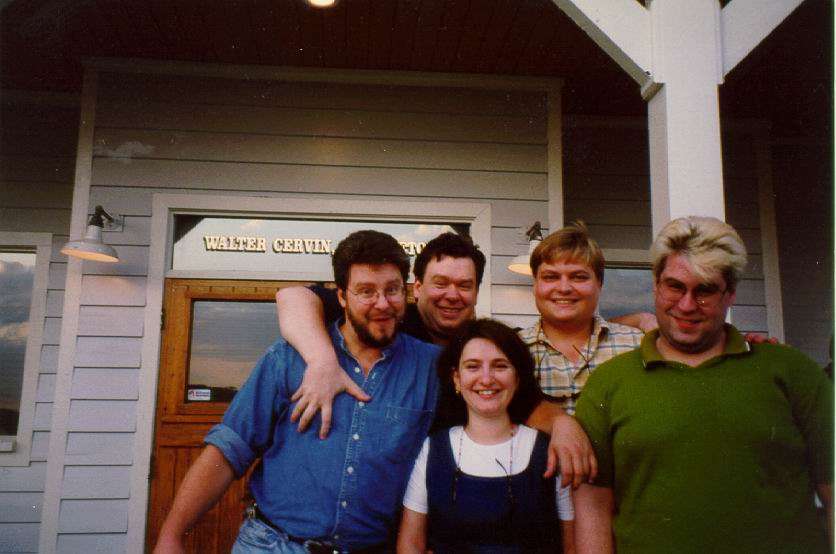
Summary & Closing
That is pretty much it for my look back at Rise of the Triad. I wanted to say thanks to you for reading. Thanks to Scott & George for hiring me 22 years ago and starting me on this journey. Thanks to Interceptor for buying 3D Realms and bringing it back to life, as well as bringing back my favorite Apogee/3DR game to the surface again. Thanks to Tom Hall & John Romero for answering my numerous questions about the past when I was writing all of this.
Over the last few months I released a few videos showing behind the scenes footage from the original video recording sessions of Rise of the Triad. I am releasing a third with this article, so enjoy that, too! There will be more than this; I will do more of these videos. The 20th anniversary of the retail version of the game is still to come (February 17th, 2015), so there’s more time to get them in for that. Haha.
Thanks for reading all of this, and thanks for being a fan of Rise of the Triad. I loved this game when we made it, and I still do.
Joe “Sebastian Krist” Siegler (Philemon 1:6)
I’m Free!

Postscript
I’m writing this paragraph about two days after the article originally went out. I’ve gotten a LOT of positive feedback on this, and I’m grateful for that. But this one tweet by Lezzer amused me more than any other. :)
@DaveOshry @DFishDesign @RiseoftheTriad I got so engrossed in this on the bus this morning I missed my stop! #TrueStory
— Lezzer (@Lezzer187) December 23, 20142020 UPDATE
Not a whole lot has changed since I wrote this piece 5 years ago. I considered doing another one for the 25th, but this one was received so well, and all I would really be doing is adding a couple of small tidbits, I decided to let this stand. A few things have come to light since this article was originally published, however.
- We lost Steve Hornback. He died on Nov 26, 2016. That was sad, as he and I used to partake of all the Chinese food buffets in the area, was a great guy to talk to and hang out. Here’s a link to our tweet announcing it.
- Susan Singer herself replied in the comments when I said we didn’t know what happened to her. She did indeed get married, and made a name for herself doing art in Sacramento. You can visit her website here.
- We lost James Storey. He died on May 30, 2015 at the age of 41. He was our first externally hired artist, coming here from England. Worked on Rise of the Triad, Duke3D, and many other titles. Here’s our announcement for James.
- That really cool “postscript” tweet at the end of the original article looks funny because the dude deleted it. GAH! I never got a screen capture of it, either.
- The “Where Are they Now” segment probably could use an update, but I don’t have the time as I write this. Of late, Tom Hall has worked with Gordon Ramsay on a cooking game, and Mark Dochtermann has worked on Pokemon Go. So there’s some high profile stuff from the ROTT team in recent years. :)
Rise of the Triad remains my fondest memory in all my years working for Apogee/3D Realms (either the old version or the new version). Was such a fun time. Might have to see about getting a beta released in the future at some point, that’d be fun. :)
Happy 25th to @RiseoftheTriad: Dark War, originally released Feb 17, 1995. #SoManyMemories
— 3D Realms (@3DRealms) February 17, 2020
We also take this anniversary as a moment to remember the late Developers of Incredible Power Steve Hornback & William "EKG" Scarboro.
A great look back: https://t.co/GhrLtf79ri pic.twitter.com/CFpFfPf1fo


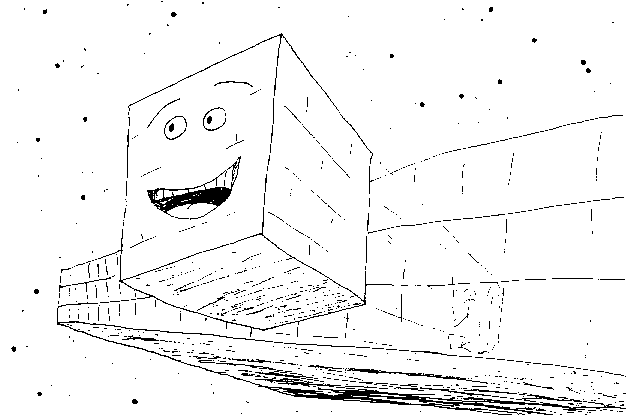
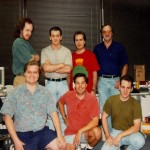
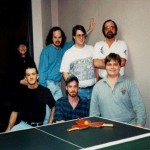
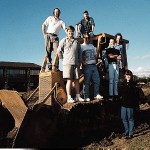
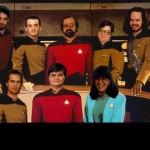

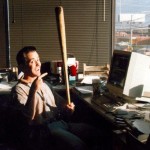



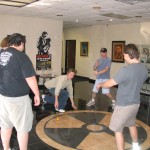
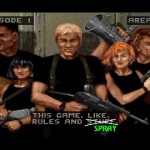
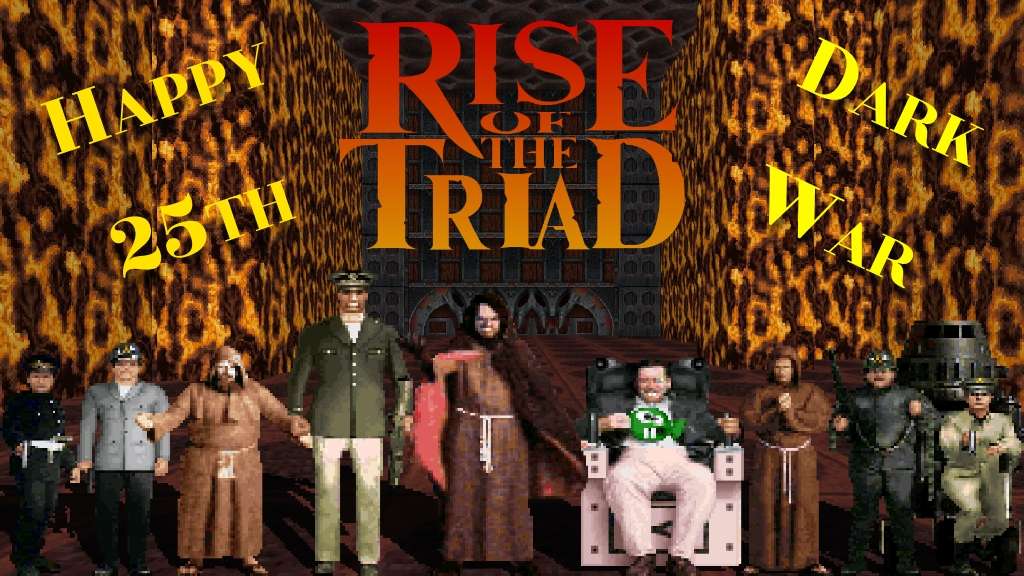
Join the Conversation
Hello Joe, very cool article here! readed it all, it was very insteresting and fun to know all these stories that happened in the good ‘ole 90’s. Love your work in ROTT, one of my favourite games. Greetings
Nice job Joe!
Well done. Fnord.
that’s interesting job you made it to the Rise Of The Triad well i make a sort of sequel of it Revenge Of The Triad
man, what an awesome article <3 lots of good stories, had some good laughs and smiles reading it. I also love how you shared your experiences regarding William; it moved me, in all honesty. I hope his mother is doing okay.
just so you know, around 1999 there was an 8 years old boy, living in Brazil's countryside, playing ROTT and crashing the game trying to kill Spray in the spinblades. that was me. hahahaha
best wishes, cheers
Nice article joe! it was nice to read up on a lot of the original development stuff, I helped develop winrott/winrottgl, though I haven’t worked on it now in quite some time,
If rott hadn’t existed, neither would winrott, thanks for a great game!
jbailey8
This was a really interesting read; thank you for taking the time to write this stuff down.
Thanks for sharing this! I can see you put a lot of effort into authoring this gem.
Thanks a lot for this article, Joe!
ROTT was the pinnacle of my early teenage years. This is the game that single-handedly convinced me to work in the video game industry. For me, ROTT with all of its then-considered technical shortcomings (90deg walls, etc) was a true gem surpassing even doom, being especially strong in the music department. Lee Jackson’s work in here inspired me to become a video game musician. I have even managed to contact him and thank him for his work (Hey there), exchanging a few mails, showing him pieces those were outright inspired by his works in ROTT. And now i’m reading this article, by every bits of reminiscence and details around the original ROTT i feel more sorry to be born too late and too far but no one can help that :)
Would love to read articles written up by the rest of the DIP clan.
david/nagz
p.s: if you had a time machine, would you rename “monk meal” to “rice of the triad”?
This article is a piece of history and so full of sweet and passionate memories that almost made me cry. Thanks.
This was highly interesting to read. It’s made me want to play the game all over again! Thanks so much for taking the time to type this up. :D
And honestly, looking at Psychedelic Eyeball’s playthrough I can safely say I never knew there were THAT many secrets in the game.
Hi Joe,
Very nice article about the ROT team. My name is now Susan Silvester (formerly Singer).
I am now a California fine artist who has made a name for myself in Sacramento region. Check out my website. I’ve done some public art and one project had a small feature segment on PBS about “The Dumpster Project”
Sad to hear about William.
Not sure you will ever see this, but I had to write. It was a nice trip down memory lane. Thanks.
See, there’s Susan. Now prove her wrong.
You seen her post.
Blub!
Peace.
\Rott\rott.exe -dopefish
Hi Joe Siegler.
I wrote up a guide for Extreme Rise of the Triad. It provides strategies for all of the main levels on the highest difficulty with only a single save at the start of each level; this also takes into account the optional decision of pistol-starting each level.
If you ever might be interested in checking it out to see how each level can be done, the link is http://erottguide.wordpress.com
Hey Joe! I’m Wayne Sikes and just ran across your site here. Way cool! I was hired by George years ago to write the commercial ROTT editor so users didn’t have to use Ted. (RoTTed) I think you and I talked several times back then. I was an editor for Game Developer Mag and did “The Chopping Block” column and did a 2 part series on ROTT. Man those were the days… I’ve moved onto other titles in the years since (founded Her Interactive and did the first 13 Nancy Drew games, also other titles such as Splatterhouse, Afro Samauri, etc.) I’m semi-retired now but still coding and gaming (I’ll turn 60 in a few months.)
Take care buddy – thanks for the great ROTT memories here ;)
Wayne
Hello from a fan in Bulgaria… while computers were a very rare thing around here during the mid-1990’s, I was on of the lucky kids. And seeing an Apogee catalog for the first time was quite exciting – so much great stuff!
RotT turned out to be one of the games I played the most during the 1990’s (along with its famous arch-rival, Doom). I always wanted to get all those Apogee games, though this goal wasn’t really accomplished until much later (around 2006).
Thank you for all the great memories!
I had just bought my first REAl gaming computer back in 1995 at Best Buy here in Evansville, IN. It was a Pentium 120! Smoking fast back in those days. it came with Descent. I was hooked forever on Gaming. I remember walking down the Game isle and one of the geeky computer guys working there pointed me to get Rise of the Triad. He said it rocked! Man was he right. I had many many hours of enjoyment playing that game. I still have the original share-ware game box with all the floppy disks as well as the original full game CD and Box. Man those were the days! I’m 60 now and I only play Xbox occasionally, but those were the bEST times. Still got the original boxes for Dukenukem, Doom, shadowwarrior, Descent, and about 100 others!!! Great read here!
ROTT was and remains my favourite game to this day, For roughly five or six years some time just after the new millennium I was really into this game, Haven’t play ROTT in sometime due to never finding it any place, Haven’t played anything that tops ROTT, Never had play combat unfortunately though one player and that maze level chasing the triad to only destroy over and over was much fun, I’d play custom .RTLs make some of my own, everything about ROTT was great, I’d argue the game is Gothic in many ways, Not trying to diminish any game from that time it was really true to itself. And original level and sprite design and music scores frigging awesome!!
Artist Steve Hornback passed away less than two years after this piece was written.
https://www.shacknews.com/article/97881/stephen-hornback-an-artist-known-for-work-on-duke-nukem-and-rise-of-the-triad-has-passed-away
Wow! ROTT was one of my favourite games when I was a kid. Thanks for sharing so many cool stuff.
Hug from Argentina.
Glad you liked the article, Zeke. Tkx!
Excellent article! All these ROTT related articles are interesting reading as fan since the shareware release. If ROTT’s not my favorite classic fps it’s certainly top 3. Anyway the mid ’90s were a great time in my life, and I spent so many hundreds of hours in ROTT back then that it’s inextricably tied to that whole era in my memory and sense of nostalgia. Now that the Ludicrous Edition’s been out for year I’ve logged about 500 more hours and it’s still just as weird, eerily atmospheric, and bloody awesome fun as I remember. Anyway before this gets much longer I just wanted to say thanks for your work on ROTT and Apogee in general, and helping to keep the ROTT legacy alive with stuff like this.
By the way, I’d kill for that framed ROTT box art that’s in the background of your last day at 3DR pic. Just saying. Time to search ebay for old retail promo stuff and hope I turn up a store poster or something.